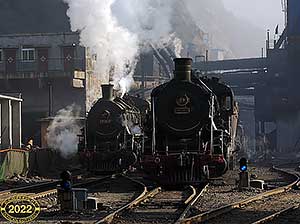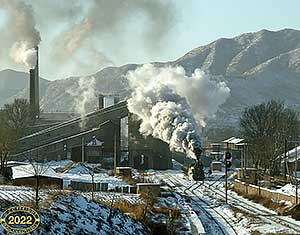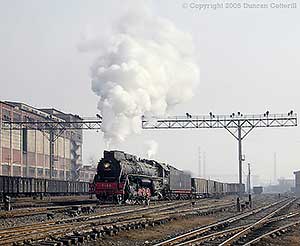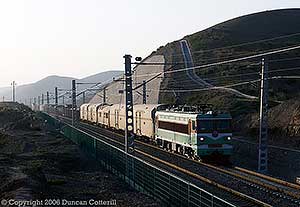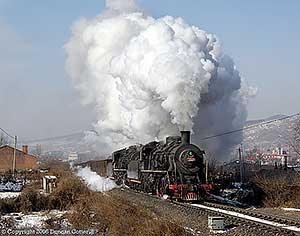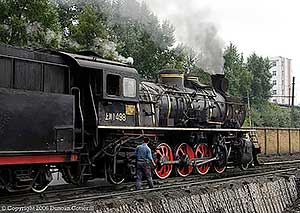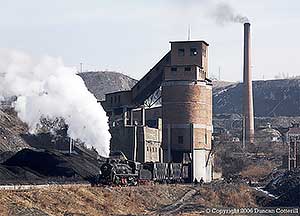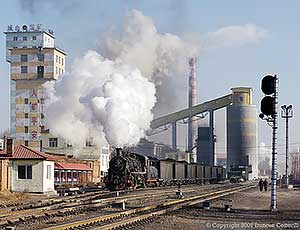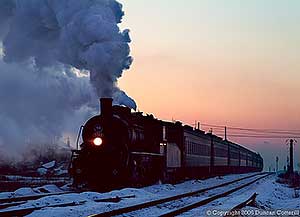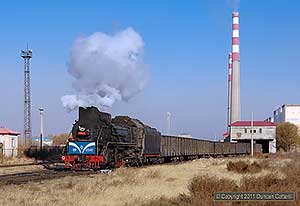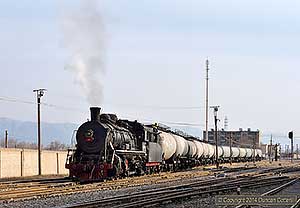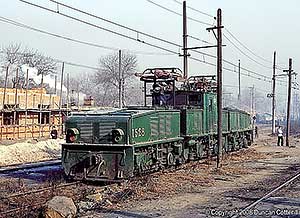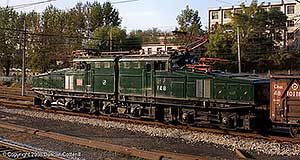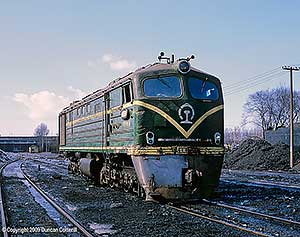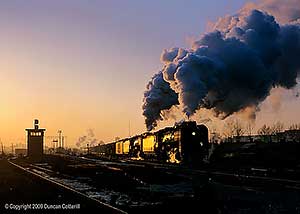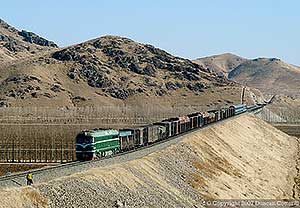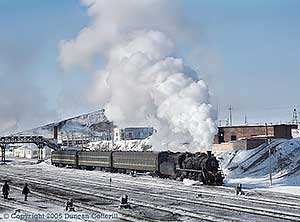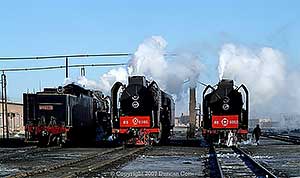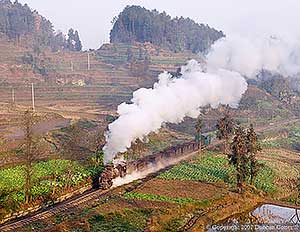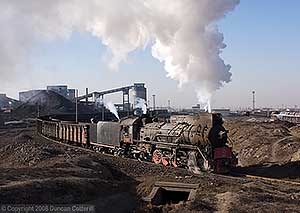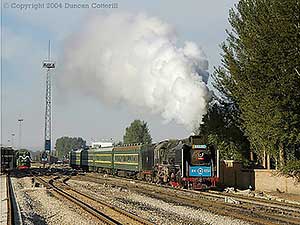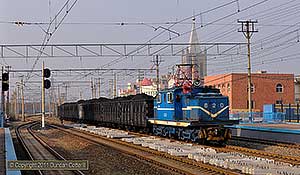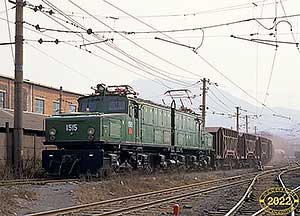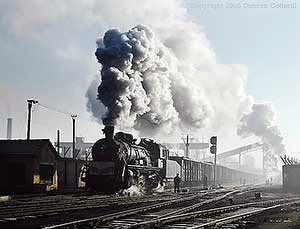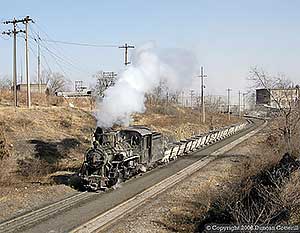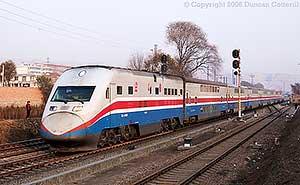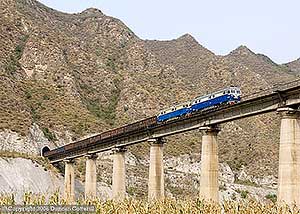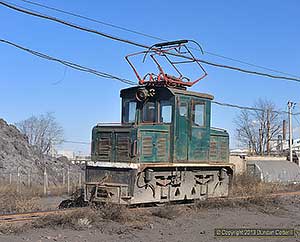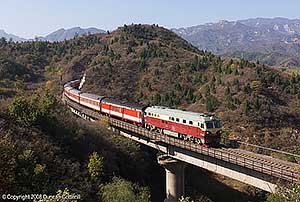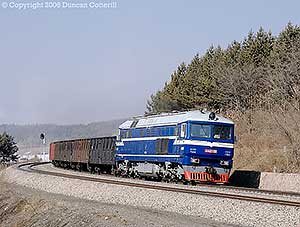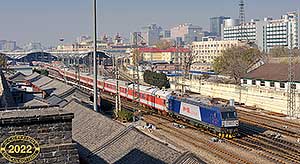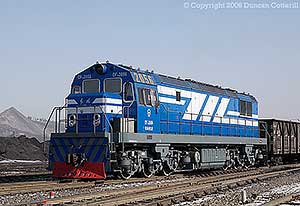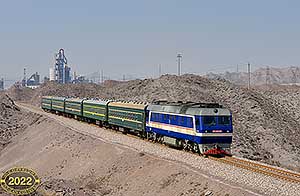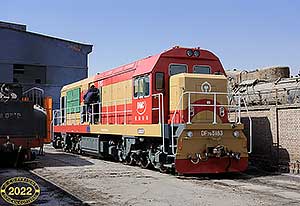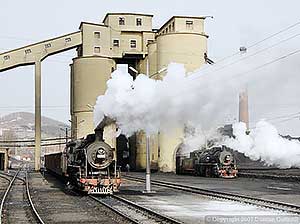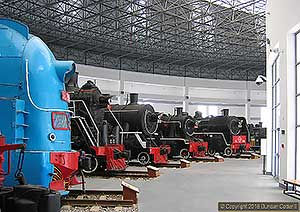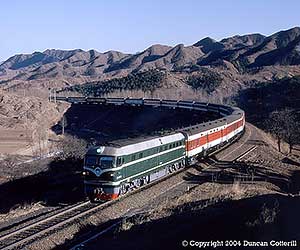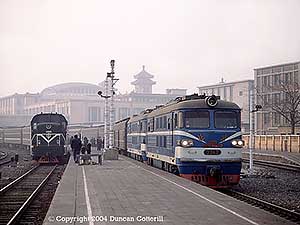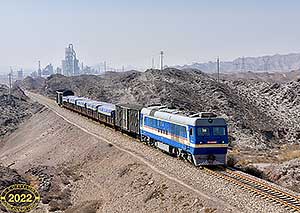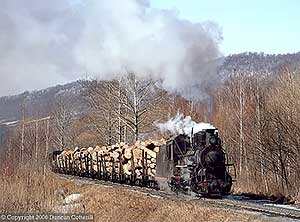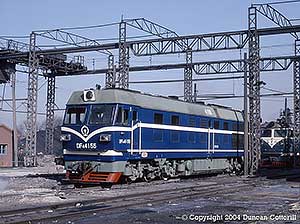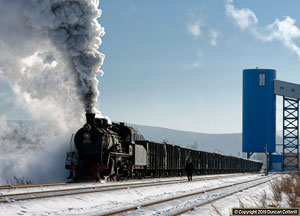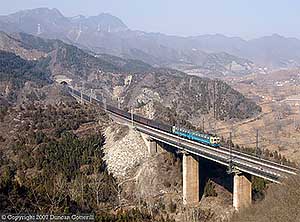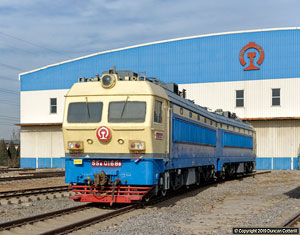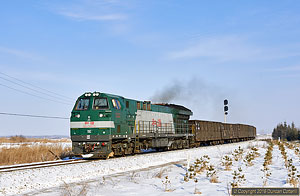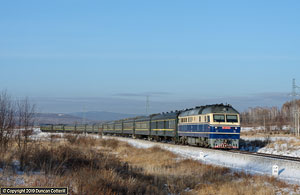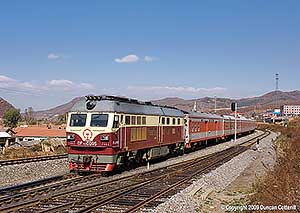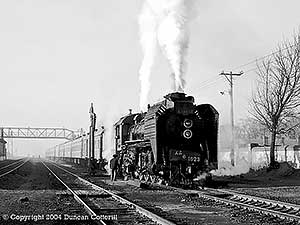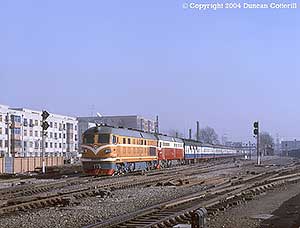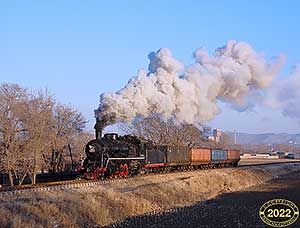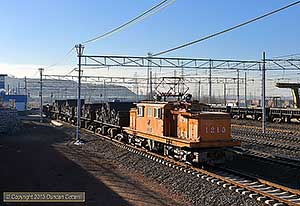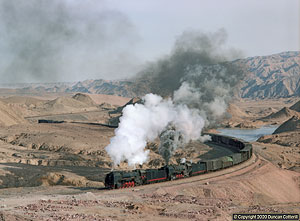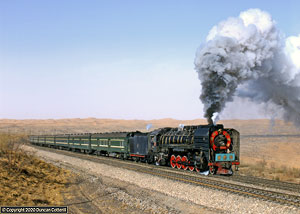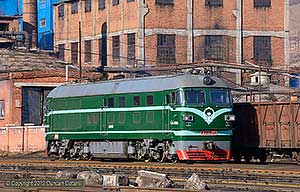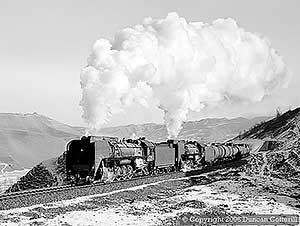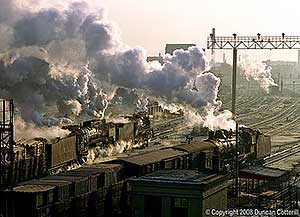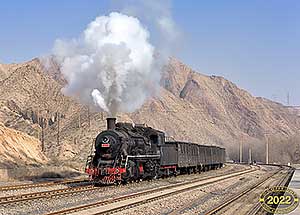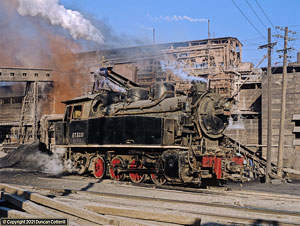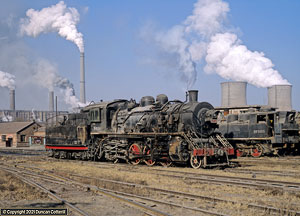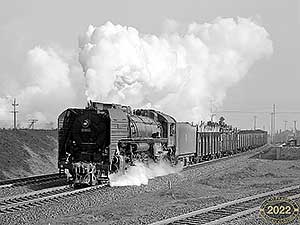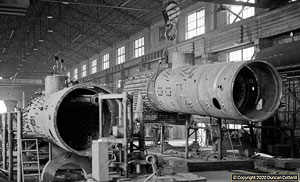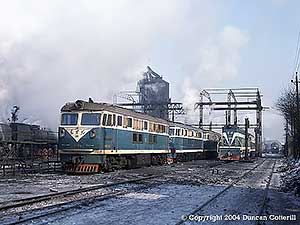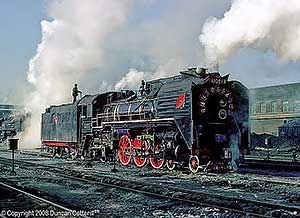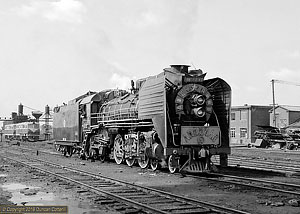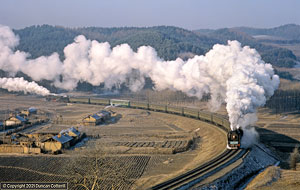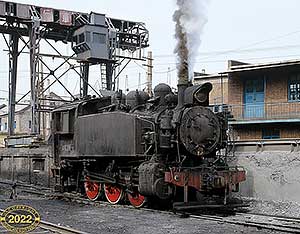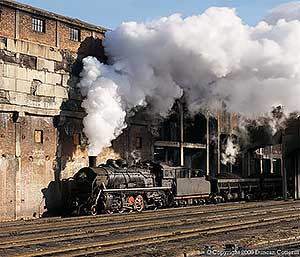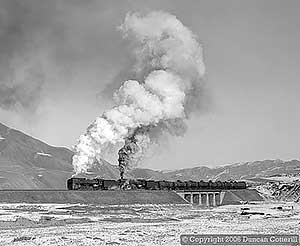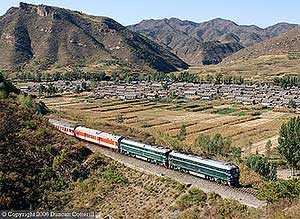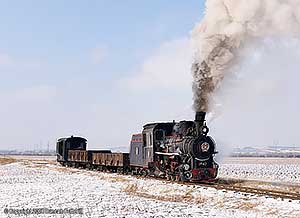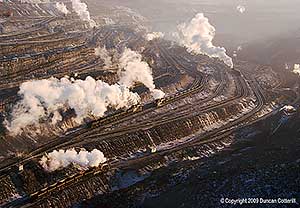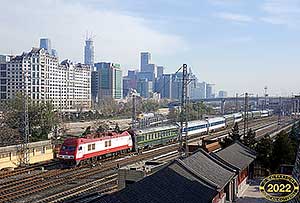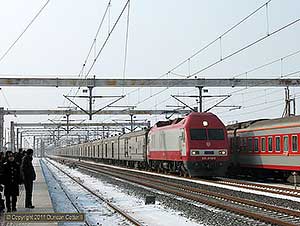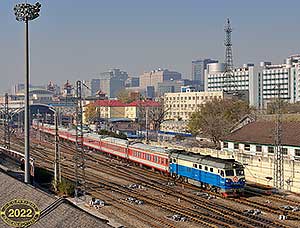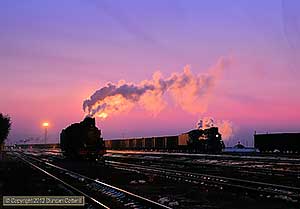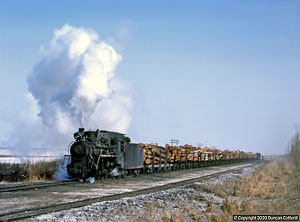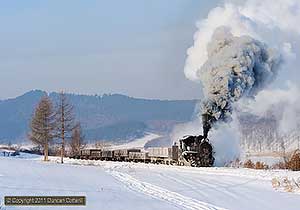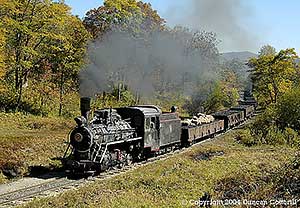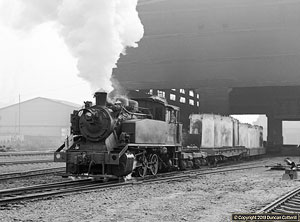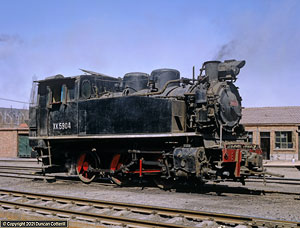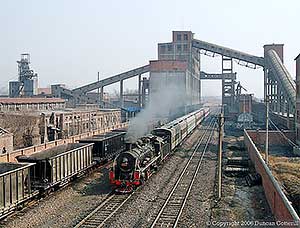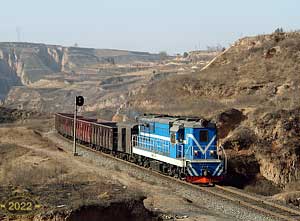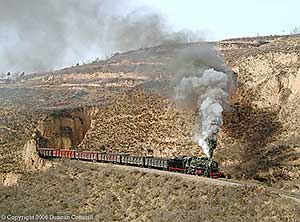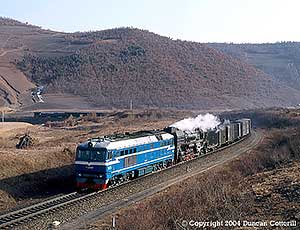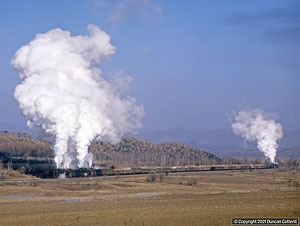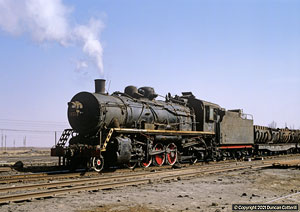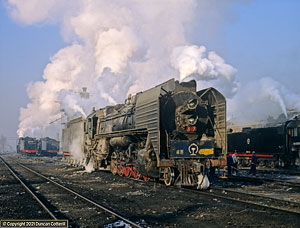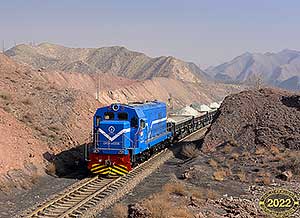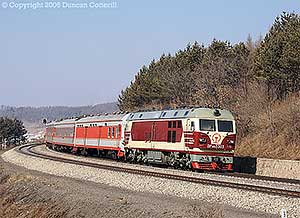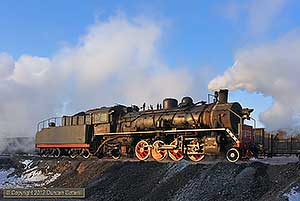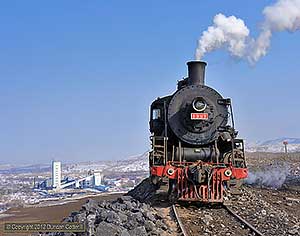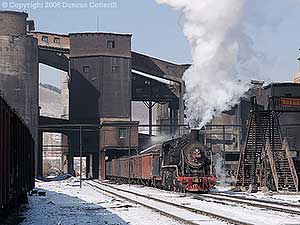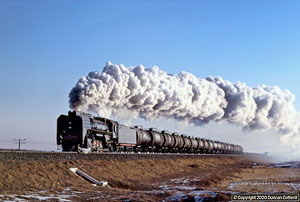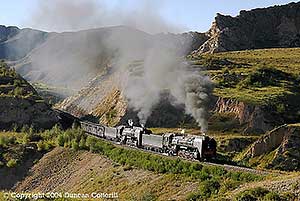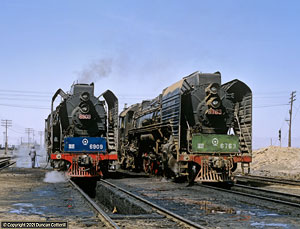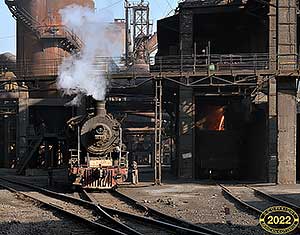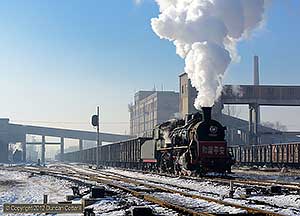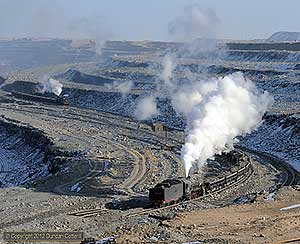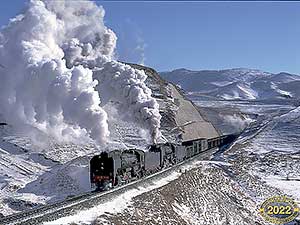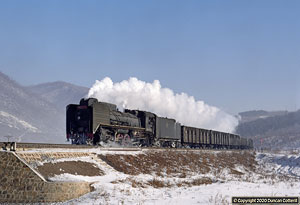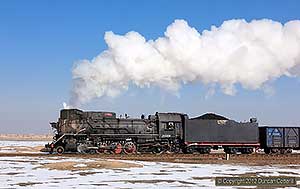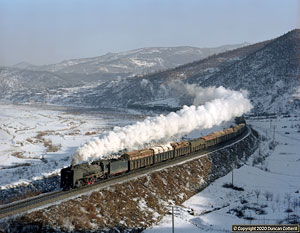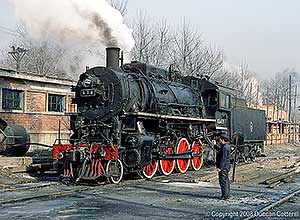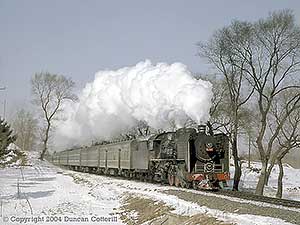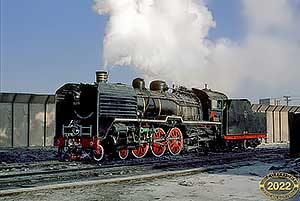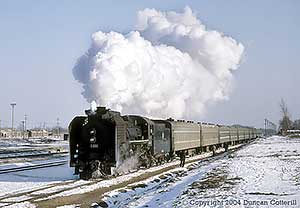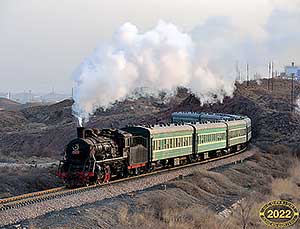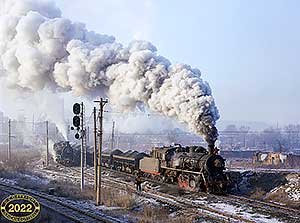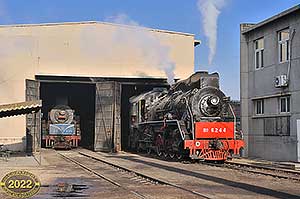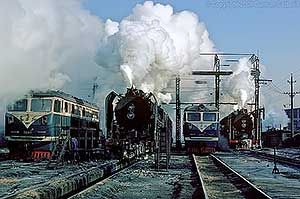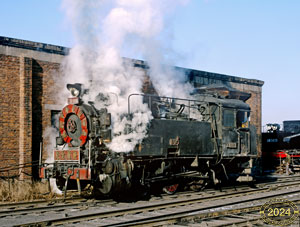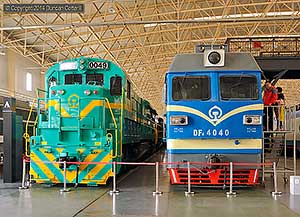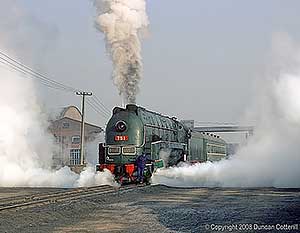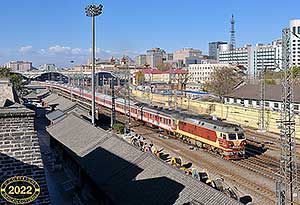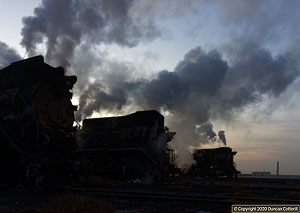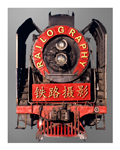Beitai Steelworks
29 photos
updated : 2016-07-11
Steam lasted longer at Beitai than any other large steelworks but access was difficult. For a short period around 2011 it was possible to get official permission to visit, but at a high price. It was worth it though, and not just for the SYs. Steam finished when the old furnaces closed around a year later.
Nanpiao Mining Railway
20 photos
updated : 2016-07-13
The Nanpiao Mining Railway is a Y shaped system in the hills west of JInzhou. It used a small fleet of SYs but acquired some second hand BJ diesels in 2003 and later got some DF5s. The last steam locos lasted until 2010.
Pingdingshan Mining Railway
24 photos
updated : 2016-07-13
The Pingdingshan Mining Railway is an extensive system serving a number of modern coal mines around Baofeng and Pingdingshan in central Henan. The line was unusual in using JS, QJ and SY classes on heavy trains. The first diesels arrived in 2004 but steam lasted until 2009 on the long line north to Yuzhou.
SS3, SS3B Class
5 photos
updated : 2016-07-15
The SS3 and SS3B Co-Co electrics were built in large numbers from 1978 to 2006 as the electrified network grew. Although primarily a freight locomotive with a maximum speed of 100km/h, the locos have also seen use on passenger trains. They are still widespread in southern and western China.
Jixi : Hengshan Mining Railway
12 photos
updated : 2016-07-15
Hengshan was the longest of the Jixi systems but not as busy as Chengzihe. It featured a steeply graded "main line" between Xinhengshan and Zhongxin as well as a long rural line to Zhangxin. It was also the first system to get diesels, in 2007, several years before the other Jixi mining railways.
Hegang Mining Railway
7 photos
updated : 2016-07-15
Hegang was a major coal mining centre for many years but, like so many mining areas in the north-east, it went into steep decline in the early years of the 21st Century. Much of the system was electrified but a significant proportion of traffic was hauled by SY class 2-8-2s until the diesels took over around 2008.
Jixi : Lishu Mining Railway
15 photos
updated : 2016-07-15
Lishu was probably the most scenic and almost certainly the least productive of the Jixi systems. Lishu's mines were located in beautiful hilly country well away from the city, so when the SYs did venture out, there were some excellent photo opportunities. Qikeng mine closed in 2008 and the line dieselised in 2010.
Jixi : Chengzihe Mining Railway
64 photos
updated : 2016-07-15
Chengzihe was the busiest of the Jixi mine railways with plenty of steam action and some of the best industrial backdrops in China. A highlight was the 8 o'clock shift change at Dongchang when the line's SYs gathered in the yard. Electrification work started in 2010 and was completed in 2012.
Tiefa Mining Railway
11 photos
updated : 2016-07-15
This busy operation serves several large coal mines north west of Shenyang and was 100% steam worked until 2004. Passengers were still worked by SYs for another few years. The area was largely flat and infested with concrete poles but had some pleasant photo positions, especially around sunrise and sunset.
Fula'erji Industrial Railways
9 photos
updated : 2016-07-15
Fula’erji is on the Nenjiang (Nen River) about 30 km south-west of Qiqiha’er and is home to a number of large industrial plants with their own rail systems. This gallery contains pictures of the smart JS class locos that used to work at the No.2 Power Station and the scruffy SY class at the Heilongjiang Chemical Plant.
Yaojie Industrial Railways
12 photos
updated : 2016-07-15
The mining town of Yaojie is home to two industrial railways, one going south through a scenic gorge to meet CNR in Haishiwan, the other heading north to an aluminium smelter and a ferro-alloy works up the Datong Valley. One line was steam worked until 2006 while the other kept a couple of SYs into 2014.
37E Class
5 photos
updated : 2016-07-15
These locos were similar, if not identical, to a large number of machines built by Skoda in the 1950s and 1960s for use on industrial railways in Eastern Europe and Russia. They consist of three separate 4-wheel units coupled together, eliminating the need for bogies and making them Bo'Bo'Bos.
ZG100 & ZG150 Class
5 photos
updated : 2016-07-15
The ZG100 and ZG150 were the local equivalents of the EL1 and EL2 and came in two versions, the ZG150-1500, a 2-section Bo+B'o+Bo, and the ZG100-1500, a single section Bo+Bo. They had noticeably longer noses and shorter full height sections than the LEW locos.
Heihe Local Railway
6 photos
updated : 2016-07-16
The Heihe Local Railway built and operated a standard gauge line between Longzhen and Heihe in northern Heilongjiang. The line started in the 1990s with a fleet of second hand DF Class diesels and was one of the last places to use them. By 2008 they had been replaced by brand new DF4Bs.
Harbin Bureau : Bei'an Area
21 photos
updated : 2016-07-16
Bei'an is off the beaten track in the north of Heilongjiang but in 1999 it was one of the last strongholds of main line steam with some very well looked after QJ and JS. In 2008 it was the Heihe Local Railway's DFs that attracted me back only to find that they had recently been replaced by DF4s.
JiTong Railway : Tongliao - Chabuga
4 photos
updated : 2016-07-16
The easternmost section of the JiTong line was flat and uninteresting for most of its 188km but the final 19km from Fuxindi to Chabuga involved a serious climb in decent scenery. By late 2003 five DF4s hired from China Rail were handling most of the traffic and steam was eliminated shortly afterwards.
Dayan Mining Railway
4 photos
updated : 2016-07-16
Dayan lies in the far north-east of Inner Mongolia, east of Haila'er, and is the location of a number of deep coal mines and a power station, all linked by a standard gauge railway system. The line had a passenger service and was totally steam worked until 2006 when the first diesels arrived.
JiTong Railway : Daban Depot
12 photos
updated : 2016-07-16
Daban was one of three depots on the JiTong line and was responsible for around half the line's fleet of approximately 100 QJ 2-10-2s. As the line dieselised from both ends, steam operations were concentrated on Daban, by then the world's last main line steam depot. The end came in late 2005.
Shibanxi (BaShi) Railway
23 photos
updated : 2016-07-16
This isolated narrow gauge operation was an absolute delight, with superb scenery, steep gradients, dilapidated rolling stock and friendly locals. All it needed was more sunshine. Since our visit in 2007, the line has become a commercialised tourist attraction, losing much of its appeal in the process.
Gongwusu Mining Railway
6 photos
updated : 2016-07-16
Gongwusu is well off the beaten track in western Inner Mongolia and wasn't discovered by enthusiasts until 2007, by which time much of the system had already closed. What remained wasn't very busy and got by with one working engine most of the time. However, there were a few pleasant locations.
Yuanbaoshan Mining Railway
8 photos
updated : 2016-07-16
The Yuanbaoshan Mining Railway serves a number of coal mines and a major power station south of Chifeng in eastern Inner Mongolia. The line was notable for its fleet of gleaming, smoke-deflector fitted JS Class 2-8-2s. Diesels arrived in 2006 but steam was still used occasionally for a few more years.
ED85 Class
6 photos
updated : 2016-07-16
The ED85s are the oldest locomotives in use in China today. The design dates from the late 1920s and most of the survivors were built in the 1940s. They were still active on the Fushun opencast mining system in the early 2010s and, unusually for China, have worn several different liveries over the past 30 years.
EL1 & EL2 Class
5 photos
updated : 2016-07-16
The EL1s and EL2s were 1500V DC industrial electrics built by LEW at the former Borsig plant in East Germany and widely used in Eastern Europe and Russia as well as China. The EL1s were Bo+B'o+Bos with articulated bodies while the smaller EL2 Bo+Bo had a single section body.
Meihekou Mining Railway
8 photos
updated : 2016-07-16
The Meihekou Mining Railway served a handful of deep mines south of the town of the same name, connecting to the national railways at Heitoushan. SYs handled most of the traffic but by 2005 there was also a DFH5 diesel in use. Steam finished around 2009.
Dahuichang Limestone Railway
6 photos
updated : 2016-07-16
The last place you would expect to find a steam worked narrow gauge railway is Beijing, China's bustling modern capital. Only a short distance from the glass and steel towers of the city, diminutive C2 class 0-8-0s shuttled tubs between the quarry and the limestone plant at Dahuichang. The line closed in 2005.
NYJ1, NZJ1, NZJ2 Class
4 photos
updated : 2016-07-16
China produced a number of diesel units in the 1990s to speed up passenger services on key routes. They followed the British HST concept with power cars permanently coupled to each end of a set of coaches. After a few years most had gone, replaced by true high-speed electric units or locos and coaches
Beijing Bureau : Beijing - Taiyuan
10 photos
updated : 2016-07-16
The line from Beijing to Taiyuan has to cross a range of mountains immediately west of Beijing and does so by following the spectacular Juma River Valley with many bridges, tunnels and superb photo locations, particularly around Shidu, a small resort town popular with the locals. These photos were taken in 2006.
Narrow Gauge Electrics
6 photos
updated : 2016-07-16
Many industrial sites had their own narrow gauge electric railways, built to a variety of gauges, and there were a number of longer distance narrow gauge lines, usually at 762mm gauge. Locos came in all shapes, sizes and colours.
Beijing Bureau : Beijing - Longhua
12 photos
updated : 2016-07-16
The Longhua line is part of a direct Beijing - Chifeng - Tongliao route built in the 1970s and opened in 1981. It has many long tunnels and may well have been diesel worked from the start. There's some excellent scenery on the Beijing - Longhua section as can be seen from the images here.
DF8 Class
9 photos
updated : 2016-07-16
The DF8 Class Co-Co diesel-electric dates from the same period as the DF4B but it was around 36% more powerful, making it ideal for heavy freight haulage. Some went to the Wuhan area but most were based at Mudanjiang, working coal trains from Jixi and Qitaihe to Harbin.
HXD3B/3C/3D Class
4 photos
updated : 2016-07-16
The HXD3B, HXD3C and HXD3D Co-Co electric locomotives were built at Dalian from 2008 as a joint venture with Bombardier. The 3 classes are intended for freight, mixed traffic and passenger work respectively. Over 2000 have been built and they can be seen on electrified lines across China.
DF5, DF5B, DF5D Class
15 photos
updated : 2016-07-16
The DF5 is a Co-Co diesel-electric for heavy shunting and trip working, powered by an 8-cylinder inline version of the engine used in the DF4. It comes in a number of variants and has found favour with the national railways and industrial operators.
Lanzhou Bureau : Baiyin Area
9 photos
updated : 2016-07-16
Baiyin is home to an interesting industrial railway system connected to a long branch that leaves the Lanzhou - Zhongwei main line at Baiyin Xi and runs east for 114km to Honghui. These pictures of diesel hauled trains on the branch were taken during gaps in traffic on the industrial railway.
DF7G Class
6 photos
updated : 2016-07-16
The DF7G is a Co-Co diesel electric designed for heavy shunting and trip work and uses a 12-cylinder version of the engine used in the DF4 series, making it considerably more powerful than the similar looking DF5. Locos are in service with the national railways and various industrial users.
Jixi : Donghai Mining Railway
8 photos
updated : 2016-07-17
Donghai is the smallest of the JIxi systems, serving a single deep mine, Donghaikuang, east of Jixi. Traffic is exchanged with CNR at Jidong station, requiring the mine's locos to leave the mining railway and run along the CNR main line for several km. The mine railway dieselised in 2010.
Shenyang Railway Museum
7 photos
updated : 2016-07-17
The Shenyang Railway Museum was established at Sujiatun in the early 1980s and contains a more interesting selection of locomotives than its counterpart at Beijing. The most unusual thing of all is that it's a museum that doesn't really welcome visitors, particularly foreign visitors.
Beijing Bureau : Chengde - Miyun
8 photos
updated : 2017-03-09
The line from Chengde to Miyun, near Beijing wasn't particularly busy but it was very scenic and most freight remained steam worked until the mid 1990s. Only a short drive from Beijing Airport, it was the ideal first destination after arriving in the country. This gallery only contains diesels at the moment.
BJ Class
9 photos
updated : 2017-03-09
The BJ was a compact powerful B-B diesel-hydraulic design equipped with a medium speed engine. The class was built at Beijing Feb 7th Works from 1975 to 1991 and dominated passenger traffic around the capital until the early 1990s. They were later cascaded to secondary lines before withdrawal.
DF8B Class
10 photos
updated : 2017-03-10
The DF8B Co-Co diesel electric was a development of the DF8 but lacked the good looks of its predecessor. The class was built from 1997 at both Qishuyuan and Ziyang. It was a useful machine for heavy freight work, rated at 3680kW, and is still in widespread use on non-electrified lines.
Weihe Forestry Railway
11 photos
updated : 2019-09-25
The Weihe Forestry Railway was one of many 2'6" gauge lines built to exploit the forestry resources of Manchuria, most of which have now closed. Weihe was one of the last to use steam and finally closed in March 2003. Most of these photos were taken a couple of weeks earlier when the railway was still busy.
DF4C Class
18 photos
updated : 2019-09-26
The DF4C was a development of the successful DF4B with a new, more angular bodystyle, a new blue livery and an uprated 16V240ZJC engine. They were quite common in northern China but rare in the south.
Wujiu Mining Railway
8 photos
updated : 2019-10-11
Wujiu is located in the far north of Inner Mongolia, 60km north-east of Yakeshi and gets very cold in winter. The railway served four deep mines, none of them particularly productive. By 2016 a diesel handled transfers to CNR at Meitian but steam was used for shunting and tripping work around the mines .
Beijing Bureau : DaQin Coal Line
6 photos
updated : 2019-10-11
This busy electrified freight line was built in the late 1980s to move coal from the Datong coalfield to Qinhuangdao port. In order to avoid the Beijing city area, it runs through the mountains to the north, using a succession of bridges and tunnels to conquer the difficult terrain. Trains are heavy and frequent.
SS4, SS4G Class
6 photos
updated : 2019-10-11
The SS4 and SS4G, were similar twin unit Bo-Bo+Bo-Bo electrics built in quantity for heavy freight haulage. The classes used to be common on the lines north and east of Beijing, including the DaQin coal line but have recently been displaced by more modern designs of European origin.
Harbin Bureau : Haila'er Area
5 photos
updated : 2019-10-11
This is the far north of Inner Mongolia, which is actually the northernmost part of China, bordering Siberia and with a climate to match. The pictures here were taken during visits to industrial lines in the area long after the end of main line steam working and feature a range of diesel classes.
DF11 Class
7 photos
updated : 2019-10-11
The DF11 is a high powered Co-Co diesel-electric designed to haul fast passenger services on non-electrified lines. As electrification has spread, these locos have been deprived of much of the work they were intended for but they still work passenger services on many secondary main lines.
DF4D, DF4DD Class
26 photos
updated : 2019-10-11
The DF4D was the final iteration of the successful DF4 line of Co-Co diesel-electrics and came in freight, passenger and high-speed versions. The class was introduced in 1996 with over 1300 built in total. Many are still in use today, working freight and passenger trains on non-electrified lines.
Shenyang Bureau : Jinzhou Area
4 photos
updated : 2020-11-12
JInzhou is a medium sized city, 242km west of Shenyang on the main line towards Beijing. It was a division point in steam days, where trains on the main line changed engines, and the junction of the line north to Yiyian. These photos were taken when passing through the area or visiting nearby industrial lines.
Shenyang Bureau : Shenyang Area
14 photos
updated : 2020-11-12
Shenyang is at the junction of three major rail routes, south-west to Beijing, south to Dalian and north to Harbin, as well as secondary lines to Fuxin, Jilin and Dandong. It was very busy for both passenger and freight traffic and steam lasted until the late 1990s although the best of it had gone five years earlier.
Beipiao Mining Railway
5 photos
updated : 2020-11-12
The Beipiao Mining Railway was a relatively quiet affair serving a number of mines spread over a wide area of countryside around the town of Beipiao in western Laioning. By the time we arrived in late 2010, the first diesel had arrived and was handling most, but not quite all, of the traffic.
Fushun Mining Railway
25 photos
updated : 2020-11-12
The opencast mine at Fushun was developed in the early years of the 20th Century and is served by an extensive electrified rail system. These pictures were taken over a period of almost 30 years, from 1984 to 2013, and show various classes of steam and electric loco and, unusually for China, EMUs.
Ningxia
19 photos
updated : 2020-11-13
Ninxia is a small desert region on the Yellow River in northern China. The main railway interest is the long route from Beijing and Baotou to Lanzhou, which crosses the region from Shizuishan to Gantang. This remained steam worked until the mid-1990s before dieselisation and then electrification.
Lanzhou Bureau : Zhongwei - Gantang
19 photos
updated : 2020-11-13
The Zhongwei - Gantang line is part of the long route from Beijing to Lanzhou via Inner Mongolia. Westbound trains climb at 1 in 80 for 60km from the Yellow River valley onto the edge of the Gobi Desert. It was a spectacular place to see double and sometimes triple headed QJs hard at work in the early 1990s.
DF4, DF4A, DF4B Class
74 photos
updated : 2020-11-13
All three classes are very closely related 3250hp Co-Co diesel-electrics, often lumped together as DF4s It would not be an exaggeration to say that the DF4 dieselised China. Well over 4000 were built from 1969 to the mid 1990s. DF4s are becoming rare in main line service but some continue on industrial lines.
Lanzhou Bureau : Lanzhou - Wuweinan
23 photos
updated : 2020-11-15
The Lanzhou - Wuweinan line is a vital link to China's north-west and carries heavy traffic. Southbound trains faced a 50km climb at 1 in 50 to Wushaoling summit, almost 10,000ft above sea level. The line was electrified in the early 1990s and the summit section closed after a base tunnel was opened in 2006.
Harbin Bureau : Harbin Area
25 photos
updated : 2020-11-20
Harbin is the capital of Heilongjiang Province and one of the main rail centres in north-east China. In the mid-1980s steam worked everything apart from a few expresses but the diesels soon took over much of the freight. This gallery contains pictures taken in the 1980s and in 2006.
Baiyin Mineral Railway
50 photos
updated : 2020-11-21
Baiyin Non-Ferrous Metals Co. owns mines and smelters in the Baiyin area of Gansu Province, producing aluminium, copper and other metals. The company's rail network extends into the mountains to the north and used a small fleet of SYs for shunting and line work, including workers' passengers, until late 2015.
ET7 Class 0-8-0T
4 photos
updated : 2021-03-09
The ET7 Class 0-8-0 tanks were built in Poland around 1960 and worked in the Chinese steel industry until the mid 1990s. Some were rebuilt as tender engines.
Baotou Steelworks
19 photos
updated : 2021-03-09
The steelworks at Baotou used a variety of steam locomotives including purpose built industrials and some former main line locos. Around 1990 locos of classes YJ, ET7, XK13, JF, JS and SY could all be found. Steam lasted until the end of 2008 but by then only the SYs were in use alongside diesels.
Shenyang Bureau : Changchun Area
46 photos
updated : 2021-03-22
Changchun is one of north-east China's major rail hubs, where the main line from Harbin to Shenyang meets secondary routes from Jilin and Baicheng. In the mid 1980s it was a steam fan's paradise with QJs on freight, SL and RM Pacifics on passengers and JFs on the shunts. It wasn't long before the diesels took over.
Tangshan Locomotive Works
6 photos
updated : 2021-03-22
Tangshan is arguably the birthplace of Chinese Railways and the locomotive works dates from the late 19th Century. It's is best known for building over 1750 SY Class 2-8-2s between 1960 and 1999. These pictures were taken on a visit in March 1988, by which time production was already tailing off.
DFH3 Class
12 photos
updated : 2021-03-22
The DFH3 was a powerful twin-engined B-B diesel-hydraulic produced in the 1970s and 1980s and largely used to dieselise passenger trains in north-east China. They weren't the most reliable locomotives and were swept aside by the same tide of DF4s and electrification that finished off main line steam.
RM Class 4-6-2
18 photos
updated : 2021-03-22
The RM Class 4-6-2 was China's final steam passenger design, combining a Russian designed boiler with a rolling chassis based on the earlier SL6 Pacific. A total of 258 were built between 1958 and 1966. Despite their relative youth, they were early victims of dieselisation with the last being withdrawn in 1990.
Harbin Bureau : Jiamusi Area
8 photos
updated : 2021-07-05
Jiamusi is a railway junction in the far north-east of China, close to the Russian border. In the late 1980s the depot's allocation consisted mainly of QJ Class 2-10-2s to work the heavy coal traffic to the west. There were also a number of RM Class 4-6-2s to work passengers. These photos were taken in 1988.
Harbin Bureau : Nancha Area
41 photos
updated : 2021-07-05
Nancha was a division point on the main line from Harbin to Jiamusi and the junction for a 257km branch into the northern forests. Freight traffic was heavy and all steam worked until the mid 1990s. Less important passengers were RM or JS hauled in the 1980s before QJs and then diesels took over.
Benxi Steelworks
5 photos
updated : 2022-08-04
Benxi Steelworks still used a number of unusual steam locomotives in 1992, including XK2 class 0-6-0 tanks, built to USATC order during WWII. The gallery includes an electric and an unusual diesel as well.
Jixi : Didao Mining Railway
37 photos
updated : 2022-08-09
The Didao system is a compact coal mining operation located north-west of Jixi, centred on the washery at Didao Hebei. Much of the steam action was tender first but it was possible to find chimney first workings and impressive industrial backdrops. Didao dieselised in Autumn 2010.
Gansu
99 photos
updated : 2022-08-09
Gansu Province lies in China's arid north west. The gallery contains images from the main lines during the transition from steam to diesel and electric around 1990 and from a few industrial lines, the last of which used steam until late 2015. There are also a few fairly recent images of main line diesels and electrics.
Hebei
19 photos
updated : 2022-08-12
Hebei Province surrounds Beijing with high mountains in the north and west contrasting with the flatlands of the south-east. Although its railways include some of the world's busiest main lines, it's the secondary lines through the hills that are more rewarding to visit. Most are still diesel worked.
Narrow Gauge
90 photos
updated : 2022-08-13
Narrow gauge lines were once a common sight in China, whether they were forestry lines, local railways or short industrial links between a quarry and processing plant, they usually have one thing in common, that they've closed, and the few that remain are probably living on borrowed time.
Zhalainuo'er Mining Railway
67 photos
updated : 2022-08-13
A large opencast coal mine in northern Inner Mongolia, entirely steam worked by SY Class 2-8-2s. Imagine Clapham Junction transplanted into the Grand Canyon and you get the idea. Probably the most spectacular steam location to survive into the 21st Century. The opencast mine system closed in 2009.
SS9, SS9G Class
6 photos
updated : 2022-11-06
A total of 43 SS9 and 173 SS9G 6400hp Co-Co electrics were built for fast passenger work by Zhuzhou between 1998 and 2006. The two variants look quite different but are similar technically. Both variants can be found working various routes from from Beijing and in the north-east.
Electrics
55 photos
updated : 2022-11-06
It wasn't until around 1990 that main line electrification it really took off. These days 25kV 50Hz electric traction is the norm on principal lines across China with many different classes of electric loco in use. Some industrial lines electrified much earlier and 1500V DC locos from the 1940s may still be in use.
Beijing Bureau : Beijing City
39 photos
updated : 2022-11-06
China's capital city dispatches trains to all corners of this vast country, worked by a great variety of loco classes. Photography around Beijing isn't easy but there are a few good vantage points, including the Dongnan Jialou, an ancient watchtower that overlooks the exit from the main station.
Sandaoling Mining Railway
288 photos
updated : 2022-11-06
Sandaoling, near Hami in the north-west of China, was home to the last steam worked opencast mine railway in the world. Rail operations within the pit have now ceased but Sandaoling still has a few working steam locos. The active steam fleet consisted mainly of JS class 2-8-2s assisted by a few SYs.
Forestry Railways
60 photos
updated : 2022-11-24
North-east China was once home to hundreds of miles of narrow gauge forestry railways but most disappeared in the 1990s, leaving only a handful to see in the 21st Century. The last true steam worked forestry lines finished in 2003, leaving Huanan, by then only hauling coal, to cling on until 2010.
Huanan Forestry Railway
47 photos
updated : 2022-11-24
This narrow gauge line in Heilongjiang carried coal rather than timber. It was a fabulous line that ran through a variety of landscapes including a hill section where loaded trains were banked. It wasn’t an easy line to photograph but it was one of the most rewarding. Closure finally came in April 2011
C2 Class NG 0-8-0
80 photos
updated : 2022-11-24
Most Chinese narrow gauge lines used 28 tonne 0-8-0 tender engines, usually known as C2s, and produced in quantity at Harbin and Shijiazhuang from 1958 to 1988. The design originated in Russia and some Chrzanow, Skoda and Mavag built locos ended up in China.
Capital Iron & Steel
4 photos
updated : 2022-11-24
Beijing Capital Iron and Steel was a large steelworks located to the north-west of the city and employed a variety of steam and diesel locomotives including ET7, SY and XK13 classes. Steel production was shifted to a new plant at Qian'an, near Tangshan and the Beijing works had closed by 2009.
XK13 Class 0-6-0T
5 photos
updated : 2022-11-24
This 0-6-0T was the smaller of 2 classes of industrial tank locos supplied to the Chinese steel industry by Poland in the late 1950s and early 1960s. The XK13 was a standard Polish industrial design known as the T3A or "Ferrum 724" and up to 82 are thought to have been built for China by Fablok in 1958-60.
Henan
26 photos
updated : 2022-11-24
Henan is a large province in eastern central China and is regarded as one of the cradles of Chinese civilisation. From a railway perspective, the main interest was the coal industry that employed large numbers of steam locos into the early 2000s, many of them powerful modern engines of classes JS and QJ.
DF7, DF7B/C/D/F Class
9 photos
updated : 2022-11-24
The DF7 classification covers a range of Co-Co diesel electrics produced by Beijing Feb 7th Works from 1981. Most were hood units intended for trip work and shunting and appear to have been relatively successful. A main-line version, the DF7D, was less successful and disappeared after a few years.
Tongchuan Mining Railway
15 photos
updated : 2022-11-24
Tongchuan lwas notable for keeping JF Class 2-8-2s in service until the end of 2004, long after the rest of the class had been withdrawn. It was a very scenic line that climbed to mines high into the hills making the old locos work for their living. Unfortunately the weather around Tongchuan was notoriously bad.
Harbin Bureau : Mudanjiang Area
23 photos
updated : 2022-11-24
In the Mudanjiang and Jixi areas of Heilongjiang freight traffic is dominated by coal from mines in the Jixi area, which travels via Mudanjiang on its way to Harbin or beyond. In the early 1990s QJs were dominant but they were later ousted by the distinctive DF8 Class diesels and different varieties of DF4.
Heilongjiang
329 photos
updated : 2022-11-24
Heilongjiang is in China's far north-east where the sub-zero winter temperatures and clear skies made it ideal for steam photography, if you could stand the cold. Main line steam lasted until 1999 but the province was also home to some of the best narrow gauge and industrial lines where steam survived another 10 years.
JF Class 2-8-2
23 photos
updated : 2022-11-24
The JF Class 2-8-2 dates back to 1918 when ALCo supplied a batch 25 locos to the Japanese controlled SMR. By 1957 around 2000 locos had been built. Locos on the national system were still in use as shunters in the late 1980s but didn't last much longer. A few survived in industrial service until 2005.
Hohhot Bureau : Baotou Area
26 photos
updated : 2022-11-24
Baotou is Inner Mongolia's second city and an major industrial and steelmaking centre on the Yellow River. It was a division point on the long main line from Datong to Lanzhou with a depot full of QJs. JSs worked the suburban service and the scenic branch to Shiguai. Steam finally finished around 2001.
GKD1, GKD1A Class
7 photos
updated : 2022-11-24
The GKD1 and GKD1A classes of diesel-electric locomotive are Bo-Bo hood units built for industrial use by Dalian Locomotive Works. Power comes from a 6-cylinder inline version of the 240ZJ engine used in many classes including the DF4 family
Diesels
210 photos
updated : 2022-11-24
Diesels were very much in the minority when I first visited China in 1984 but there was plenty of variety. As DF4s eliminated steam and earlier diesel classes from the main lines, everything became very uniform but variety returned later with new main line and industrial classes appearing.
SY Class 2-8-2
483 photos
updated : 2022-11-24
The SY Class 2-8-2 was China's standard industrial locomotive for the last few decades of the steam era. Over 1800 were built between 1960 and 1999, to a design derived from a 1920s ALCo light Mikado. The SYs were versatile machines and handful remained in industrial service until around 2018.
Fuxin Mining Railway
78 photos
updated : 2022-11-24
Fuxin was a major coal mining centre for many years but most of the mines have now closed. The once extensive electric system has been dewired and much of it closed. Steam continued in use until 2016, by which time traffic had declined to the point that it could be handled by the railway's few diesels.
Deep Coal Mines
429 photos
updated : 2022-11-24
Deep coal mines provided employment for more steam locomotives than any other industry in China and that continued until very recently. Many mine systems included lines running through attractive countryside and interesting industrial architecture. Diesels on mine systems have not been ignored.
JiTong Railway : Chabuga - Daban
79 photos
updated : 2022-11-24
The 155km section east from Daban to Chabuga had the honour of being the world's last steam worked main line, finally succumbing to diesels in late 2005. What a superb line it was, with wide open spaces, distant mountains, long inclines and no shortage of excellent photo positions.
JiTong Railway : Daban - Haoluku
148 photos
updated : 2022-11-24
The 204km line from Daban to Haoluku opened at the end of 1995 and included the climb over Jingpeng Pass. It was a photographic paradise with plenty of bridges, tunnels and horseshoe curves set in glorious mountain scenery. The first diesels arrived in late 2004 and steam had finished by early 2005.
QJ Class 2-10-2
412 photos
updated : 2022-11-24
The QJ Class 2-10-2 was developed from the Soviet LV Class, probably based on the OR21 protoype that never went into production. Datong Works built over 4700 QJs from 1964 to 1988. The class worked main line freights all over China until the end of steam and could also be found on passenger trains.
Steelworks
65 photos
updated : 2022-12-03
The steel industry was the third biggest employer of steam locomotives in China, after the national railways and the coal mines. Getting permission to visit steelworks was difficult but not impossible. They weren't the easiest places to get good photos but could be very rewarding in the right conditions.
Pingzhuang Mining Railway
36 photos
updated : 2022-12-03
Pingzhuang's mining railway served five deep coal mines and an opencast pit. The opencast electric system closed some time ago and the deep mine system got a pair of diesels at the end of 2013, after which the SY's didn't have a lot to do. Traffic levels were never high but some good shots were possible.
Opencast Mines
336 photos
updated : 2022-12-03
Steam worked opencast mines are the most incredible places to see and photograph steam locomotives, whether looking down from the rim at a dozen locos scurrying back and forth or getting in close at the coal face. Zhalainuo'er (Jalainur) lasted until 2009 and Sandaoling hung on into 2022, just.
Nei Menggu (Inner Mongolia)
424 photos
updated : 2022-12-03
Inner Mongolia covers a vast area of northern China was one of the most rewarding provinces for the steam enthusiast. It was home to the JiTong Railway, the Zhalainuo'er opencast coal mine, Baotou, with it's steelworks and JS worked suburban passengers to mention just a few of the many highlights.
Shenyang Bureau : Tonghua Area
36 photos
updated : 2022-12-03
The network around Tonghua was built to take Chinese coal and minerals to the Korean ports to fuel Japan's war effort. This is a very attractive part of China with wooded hills and picturesque river valleys and provided the perfect setting to photograph steam locos in the 1990s and diesels a decade later.
JS Class 2-8-2
362 photos
updated : 2022-12-03
The JS Class 2-8-2 was designed as a main line freight locomotive, a development of the JF Class 2-8-2s introduced on the SMR in 1918. The JS was in production at several different works from 1957 to 1988 and over 1900 were built. A handful remained in industrial service into the 2020s.
Main Line Freight
375 photos
updated : 2022-12-03
China's railways still carry incredible volumes of freight traffic with freight trains outnumbering passengers on most lines by quite a margin. As on most systems there are block trains of coal, containers or oil tanks but also a large volume of wagonload freight, making for interesting consists.
KD6 Class 2-8-0
3 photos
updated : 2022-12-03
The KD6 Class consisted of at least 20 USATC 2-8-0s, a type commonly known as the S-160. The Chinese engines were
used in main line service initially but most had migrated to coal mines in the North-East by the 1980s. Most, if not all, received larger cabs and taller chimneys after arrival in China.
Shenyang Bureau : Jilin Area
40 photos
updated : 2024-04-20
Jilin is an industrial city on the Songhua River and an important railway junction. Its petro-chemical plants generate much of the area's freight traffic but it was the SL6 Pacifics that drew us there in the late 1980s. Jilin had the last operational examples of the class and kept them in excellent condition until the end.
SL6 Class 4-6-2
26 photos
updated : 2024-04-20
The SL6 Class 4-6-2 was one a number of Pacific classes introduced during the Japanese occupation of Manchuria, with a final batch built in the 1950s. Despite the SL6 being a much older design than the RM, they outlasted their younger cousins by a year with the last survivors working until 1991
Jilin
133 photos
updated : 2024-04-20
Jilin Province had much to offer in the 1980s and 1990s. RM and SL6 Pacifics worked from Changchun and Jilin and there was plenty of QJ worked freight. The JS worked lines around Tonghua and Hunjiang were amongst the most photogenic in China and there were a few good industrial operations as well.
Passenger Trains
246 photos
updated : 2024-04-20
Passenger trains weren't confined to the national system in China, with many local and industrial railways running their own services. Main line passenger traffic was booming pre-Covid with frequent high-speed EMUs on principal routes as well as more traditional long distance and local trains everywhere else.
Liaoning
212 photos
updated : 2024-04-27
Liaoning is in China's heavily industrialised north-east and is home to busy main lines and some of the most interesting industrial systems, several of them electrified. Steam lasted on the main lines until the start of the 21st Century and hung on in industrial service until 2016.
Miscellaneous Industrials
31 photos
updated : 2024-04-27
Visits to a number of industrial operations only produced one or two worthwhile pictures, not enough to justify a gallery in their own right. These pictures are grouped together here.
Sheds and Workshops
183 photos
updated : 2024-04-27
Locomotive depots, servicing points and workshops can be very photogenic places providing a contrast to photos taken at the lineside. In China servicing was usually carried out in the open air, even in the frozen north in winter. The lack of light was a challenge in sheds, where they existed, and workshops.
GJ Class 0-6-0T
3 photos
updated : 2024-04-27
The GJ Class was an 0-6-0T built for industrial use at Taiyuan and Chengdu between 1958 and 1961. Many worked in the steel industry but others were used by railway workshops including Datong and Sujiatun, where the final example was retired around 2006. A few were exported to Vietnam.
Beijing Railway Museum
10 photos
updated : 2024-04-29
The Beijing Railway Museum houses a large collection of steam, diesel and electric locomotives and other rolling stock. Many of the exhibits seem to have been selected for being unusual rather than being typical examples from the working railway but it's still a fascinating place to visit.
Preserved Locos
24 photos
updated : 2024-04-29
China has a surprisingly large number of preserved locomotives although very few are operational. There are two large museums, in Beijing and Shenyang, plus a few smaller collections but most locos are plinthed at locations such as stations factories or locomotive depots, many of which are inaccessible to the public.
Beijing
86 photos
updated : 2024-04-29
Beijing Municipality includes a lot of countryside as well as China's Capital City. Photography in the city isn't easy but there are plenty of good photo locations away from the urban area with dramatic mountains and plenty of railway action with a bewildering number of different classes in evidence.
Steam
1414 photos
updated : 2024-04-29
China was the last country in the world to use steam locomotives in quantity and a handful still remain in service today. It was a very different story in the 1980s and 1990s, with thousands of locos of different classes and gauges hard at work across the country on the national network, local railways and in industry.
It's difficult to comprehend the scale of China's railway system or the speed with which it's changed over the last few decades. The photos here are the result of dozens of visits to main line and industrial locations across the country since 1984 and depict many classes of steam, diesel and electric loco at work.




 options
options hide options panel
hide options panel